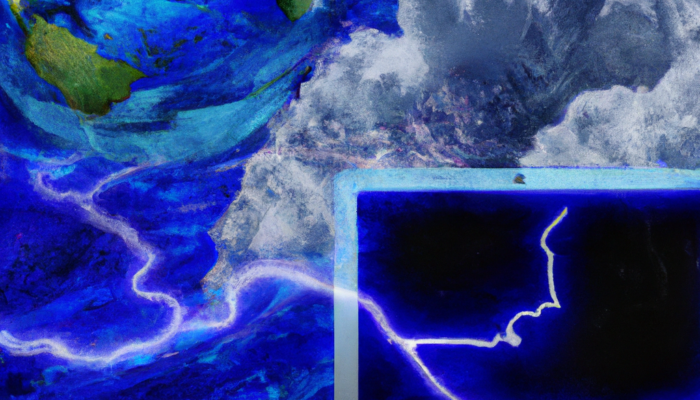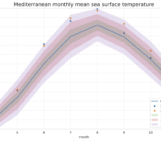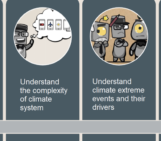
In the blistering heat of July 2023, a series of violent thunderstorms struck the serene landscapes of northern Italy, leaving behind a trail of devastation, despair, and grief. Unleashing their fury upon the unsuspecting region, these tempestuous storms unleashed torrential rains, hailstones the size of tennis balls, and ferocious winds exceeding 150 km/h. Amidst the chaos and destruction, homes were torn asunder, crops were obliterated, and communities were left reeling from the untimely loss of loved ones. As the people of northern Italy grappled with the aftermath of this catastrophe, a pressing question arose: was there a link between these extreme weather events and the specter of climate change? In this harrowing tale of nature’s wrath, we delve into the events that unfolded during those fateful days and explore the potential relationship between these violent thunderstorms and the ever-growing concerns about the influence of climate change on our planet. In this blog article, we try to understand the challenges of predicting and preparing for such extreme weather events in a warming climate.
The Unpredictable Nature of Thunderstorms
Storms are notoriously difficult to predict with pinpoint accuracy, especially when it comes to localized aspects like the number of lightning strikes, tornadoes, and hail intensity. Meteorological models, which typically have data points every 5 kilometers, are not finely tuned enough to account for the highly localized and chaotic nature of storms that can cover just a kilometer. This uncertainty arises due to the influence of minute, unpredictable factors that can alter a storm’s path or intensity, also known as the “butterfly effect.” Despite detailed forecasting efforts, the exact number of such occurrences remains elusive. Measuring the intensity of a storm is a complex task. It involves setting local thresholds, such as precipitation levels, for specific regions. What might be considered a significant amount of rain in one city may not be the same in another due to various geographical factors, such as mountains and landscapes. Additionally, the energy available for atmospheric convection, which triggers thunderstorms, is a crucial factor in determining the intensity of a storm. That’s why thunderstorms are difficult to predict but also to study in a climate change context.
Climate Change and Thunderstorms, what we know?
Recent violent storms in Italy appear to be unprecedented for intensity, geographical extensions and damages to the community. They have been originated from the convergence of the very warm air from the south brought by the strongest mediterranean heatwave on the records and cold air from the north. While the heatwave was already attributed to climate change, can we say something specific about the link between climate change and thunderstorms?
Recent studies indicate that global warming is amplifying the frequency and intensity of storms in both Europe and the United States. As the Earth’s atmosphere heats up, it accelerates the process of evaporation, leading to higher levels of moisture in the air. This increased moisture content provides storms with a greater energy source, as water vapor acts as fuel for their development and intensification. As warm, moist air rises and collides with cooler air masses, it creates the ideal conditions for thunderstorms to form and unleash their fury. The increased energy and moisture in the atmosphere not only fuel the intensity of these storms but also contribute to the formation of larger and more destructive hailstones. As updrafts within thunderstorms become stronger, they can suspend hailstones in the storm’s core for more extended periods, allowing them to grow larger before finally falling to the ground. These large hailstones pose a significant threat to property, crops, and even human lives. In addition, the warming climate can lead to changes in atmospheric circulation patterns, which can influence the frequency and tracks of storms. This altered atmospheric circulation can result in storms lingering over specific regions for extended periods, leading to more prolonged and intense rainfall events, increasing the risk of flooding and landslides. While it is challenging to attribute individual weather events directly to climate change, the pattern of increasing storm frequency and intensity aligns with the predictions of climate models. The scientific consensus indicates that as global temperatures continue to rise, the frequency of severe thunderstorms and hail events is likely to increase further, posing a growing threat to vulnerable regions like northern Italy and other parts of the world.
Preparing for a Stormy Future
In the face of escalating storm risks, the best defense lies in reducing greenhouse gas emissions. By curbing the emission of greenhouse gases, we can slow down the rate of climate change and mitigate the occurrence of even more powerful storms. This is especially critical for regions with small watersheds, where heavy rainfall can lead to rapid flooding, as observed in the Alps, Apennines, and in other mountain ranges in Italy and Europe. Understanding the impacts of storms under different climate scenarios requires more extensive research and the use of artificial intelligence to analyze observed data and project future outcomes. By combining historical, current, and predictive data, scientists can better model the effects of storms, such as rainfall amounts, hail size, and the likelihood of tornadoes. Armed with this knowledge, policymakers and communities can implement adaptive measures to protect lives, infrastructure, and economies.
The increasing frequency and severity of violent storms in Italy have put the spotlight on the challenges of predicting and adapting to such extreme weather events in a warming climate. While exact locations and intensity of single storms remain unpredictable due to their chaotic nature and the limitations of current meteorological models, recent studies suggest that their intensity and frequency will lead to more destructive events in a warmer climate. As we face a critical turning point in our understanding of climate change, it is imperative to prioritize research, reduce greenhouse gas emissions, and implement proactive measures to safeguard communities from the impacts of nature’s unleashed fury.




